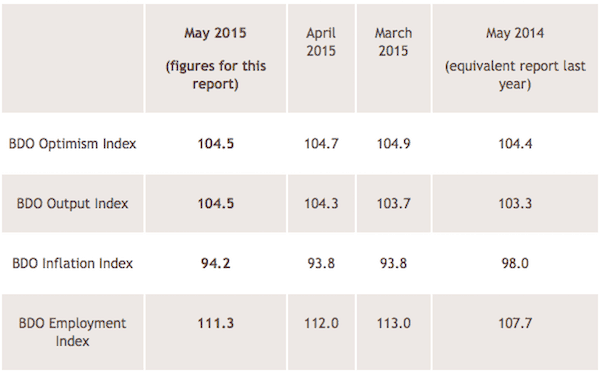In their latest Business Trends Report, the firm of accountants and business advisers note that May 2015 was problematic for Britain’s manufacturers, who reported the biggest decline in optimism since March 2013.
In line with other key indicators such as the latest UK Manufacturing PMI and the EEF/DLA Piper manufacturing growth forecast, exporters have been frustrated by sluggishness in the Eurozone and the cost of sterling pushing up the price of UK-made goods. BDO add that low oil and gas prices have curbed investment by the sector, and slowed orders for manufacturing firms.
BDO’s Manufacturing Optimism Index stands at 103.4, which is above the long-term average but offset against the sector’s performance since the start of the financial crisis.
BDO contacts over 4,000 different respondents from companies employing approximately five million employees for its report, which includes Optimism and Output Indices, which predict overall UK business growth for the latter part of 2015.
Reflecting on today’s announcement, and ahead of the Budget on July 8, Peter Hemington, partner, BDO LLP, suggested that a formal target should be set for manufacturing’s share of GDP, which in turn would lay the foundations for a sustainable industry policy that could be overseen by a dedicated Minster for Manufacturing.
He added that plans for a Northern Powerhouse need to be translated into real support for the manufacturing sector and, more widely, that reducing National Insurance for manufacturers taking on new employees could create up to 90,000 jobs each year, boosting GDP by over £3.5bn. The full report from BDO can be found here.

More advice for the government comes today from the Solar Trade Association, which suggests that solar energy could be as cheap as fossil fuels by 2020.
In Solar Independence Plan for Britain the trade association sets out how David Cameron’s government can bring the price of rooftop solar in line retail electricity prices, and bring utility-scale solar farms to parity with new gas CCGT power station prices in five years.
They say their report addresses different scenarios and suggest government aim for a 25GW target for solar by 2020.
They say: ‘If adopted, the Plan could see 2.1 million solar homes, 24,000 commercial rooftop and community schemes, 2,300 good quality solar farms and almost 57,000 jobs in solar and its supply chains. Achieving this breakthrough would in 2020 cost households around £13 per year.’
Click here for the full report.
Whilst we’re on solar energy, The June 2015 edition of The Engineer features Prof Ravi Silva who describes how the drive for clean technology has resulted in a ‘race to the top’ for the photovoltaic research community.











National Gas receives funding to develop Gravitricity underground hydrogen storage system
One single rock salt mine - Winsford - has 23 <i>MILLION </i>cubic metres of void and even allowing for 10% of that void set aside for hazardous waste...